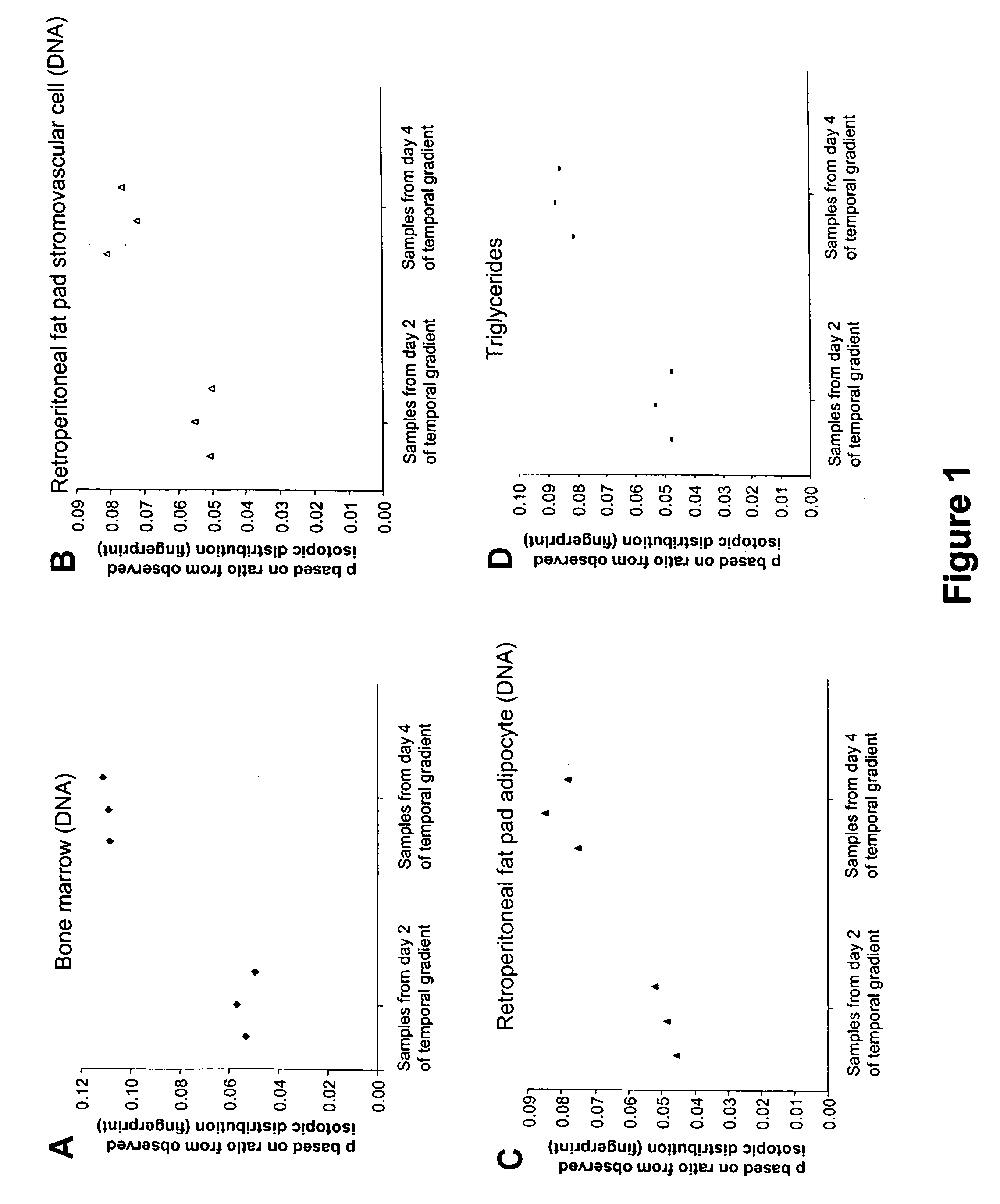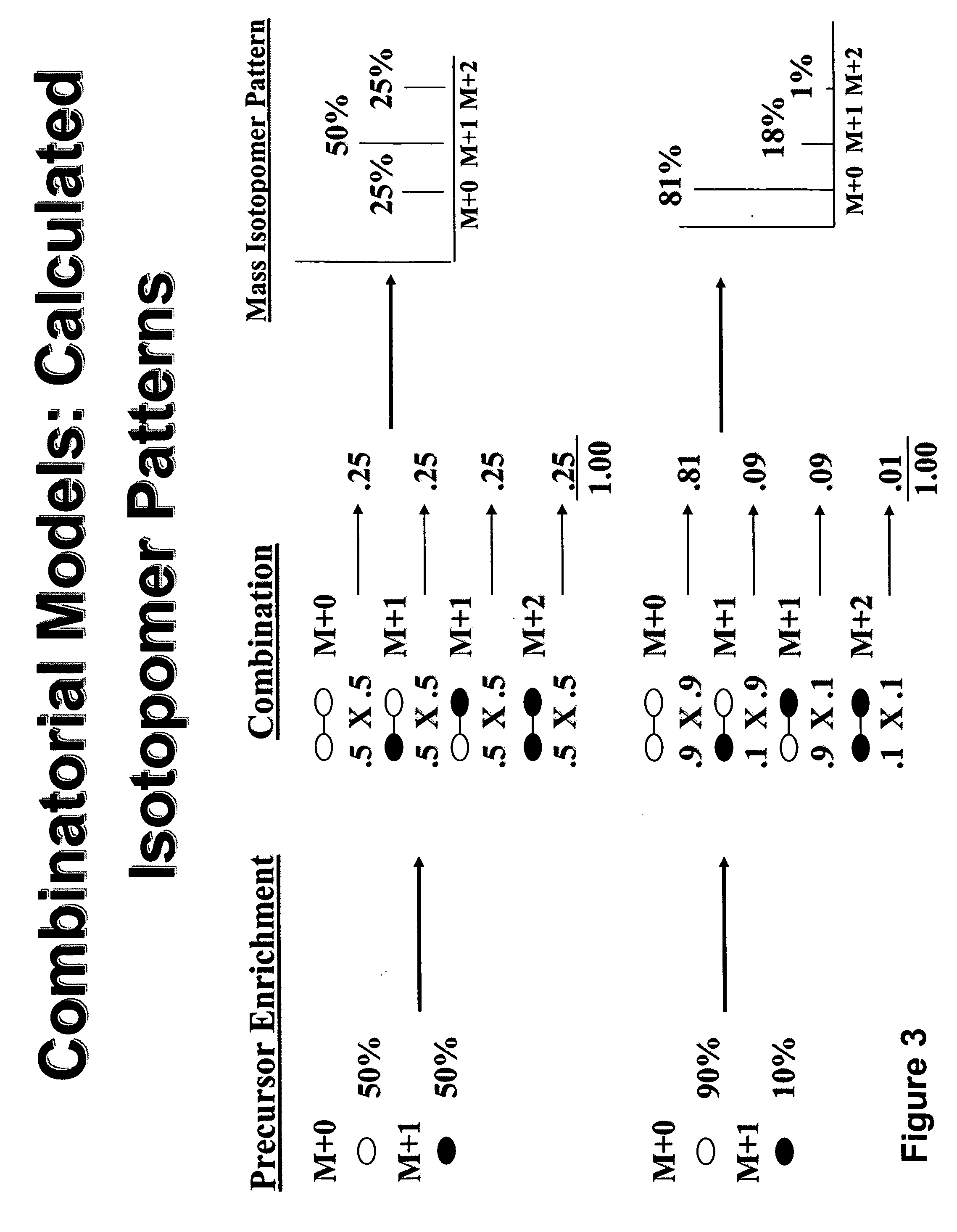Temporal or spatial characterization of biosynthetic events in living organisms by isotopic fingerprinting under conditions of imposed isotopic gradients
a biosynthetic event and isotopic fingerprinting technology, applied in the field of temporal or spatial localization determination of a biosynthetic process of interest, can solve the problems of requiring disruption of the process, no generally applicable noninvasive post-hoc method to establish the timing or sequence of biochemical events,
- Summary
- Abstract
- Description
- Claims
- Application Information
AI Technical Summary
Problems solved by technology
Method used
Image
Examples
example 1
Livid Synthesis in Mouse Embryos
[0136] Female mice (Blk / 6J) are administered 2% 2H2O in drinking water starting one day prior to housing with male mice (one female and one male per cage). Female mice then become pregnant usually within 3 days. The drinking water content of 2H2O is increased by 2% every 5 days (e.g., to 4% at day 5, 6% at day 10, and 8% at day 15). Urine is collected daily and 2H2O content is measured by a gas chromatographic / mass spectrometric method.
[0137] On day 18-20, pregnant mice are sacrificed and the fetuses collected. Fat is extracted from visceral tissues and brain of fetuses, separated into triglycerides and phospholipids by thin layer chromatography, transesterified to fatty acid-methyl esters, and analyzed by GC / MS for isotope pattern. Predicted isotopic labeling patterns are calculated as described, supra, for example from tables prepared as described in the several MIDA references cited, supra, and previously incorporated by reference. The predicted ...
example 2
Plasma Protein and Triglyceride Synthesis in Humans
[0138] Healthy human subjects are administered 70% 2H2O orally for 4 weeks. The initial 2H2O dosing regimen is 35 mL three times per day (morning, mid-day, and evening) for 4 days, then twice a day for 7 days, followed by once a day for 17 days. Urine is collected every 7 days for measurement of 2H2O enrichment by GC / MS.
[0139] Blood samples are collected weekly. Plasma very-low-density lipoproteins (VLDL) are isolated by ultracentrifugation. Apolipoprotein B is precipitated from VLDL with heparin and hydrolyzed to free amino acids with 6N HCl in sealed tubes at 110° C. The amino acids are derivatized and analyzed by GC / MS. The 2H labeling pattern is measured for N-acetyl, N-butyl esters of glycine (m / z 174 and 175) and alanine (m / z 188 and 189). Lipids are extracted from VLDL and transesterified to fatty acid methyl esters. The free glycerol remaining after transesterification of acylglycerides is derivatized to glycerol triacetat...
example 3
DNA and Triglyceride Temporal Isotopic Gradient in Rat Tissues
[0141] Establishing a temporal gradient in vivo. A temporal gradient of a stable isotope labeled precursor (2H2O) was established in rats as follows. Rats were given a bolus of 100% 2H2O to give a body water value of 5% excess 2H2O, then kept on 30% 2H2O (via drinking water). Based on historical data, this regimen results in a steady increase of excess 2H2O in body water from 5% on day 1 to a maximum of 15-18% at approximately day 4. Thus, a 4 day temporal gradient of 5 to 15% of 2H2O was established in rats for this study.
[0142] Measuring the isotopic fingerprint. During the period of label administration (the 4 day temporal gradient) three animals were sacrificed on day 2 and three on day 4. From these animals, bone marrow and retroperitoneal fat pads were harvested. These samples were further processed: DNA was isolated from the bone marrow samples, and fat pads were separated into adipocyte (fat storing cells) and s...
PUM
| Property | Measurement | Unit |
|---|---|---|
| mass spectrometry | aaaaa | aaaaa |
| NMR spectroscopy | aaaaa | aaaaa |
| time | aaaaa | aaaaa |
Abstract
Description
Claims
Application Information
 Login to View More
Login to View More - R&D
- Intellectual Property
- Life Sciences
- Materials
- Tech Scout
- Unparalleled Data Quality
- Higher Quality Content
- 60% Fewer Hallucinations
Browse by: Latest US Patents, China's latest patents, Technical Efficacy Thesaurus, Application Domain, Technology Topic, Popular Technical Reports.
© 2025 PatSnap. All rights reserved.Legal|Privacy policy|Modern Slavery Act Transparency Statement|Sitemap|About US| Contact US: help@patsnap.com



